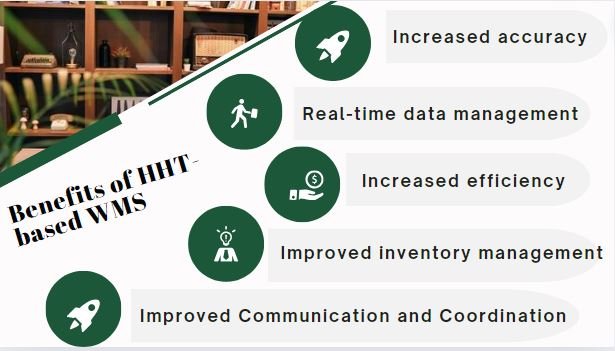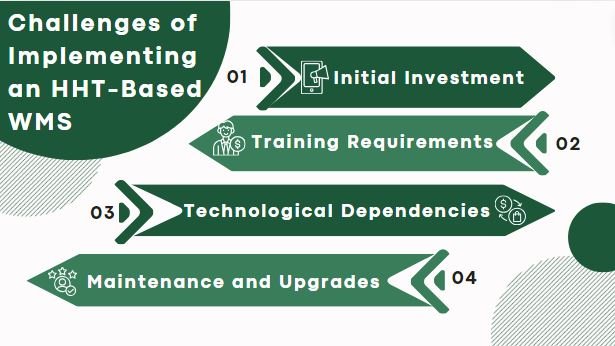- Introduction
- What is a Handheld Terminal (HHT) based WMS?
- Benefits of HHT-based WMS
- Challenges of Implementing an HHT-Based WMS
- Case Studies: Success Stories with HHT-Based WMS
- Future Trends in HHT-Based WMS
- Conclusion
- Frequently Asked Questions
- What is a handheld terminal (HHT)-based WMS?
- How does an HHT based WMS improve accuracy in warehouse operations?
- Advantages HHT-Based WMS
- What are the main benefits of using an HHT based WMS?
- How does a HHT based WMS handle real-time data management?
- Can HHT-based WMS integrate with other warehouse systems?
- disadvantages HHT-Based WMS
- What challenges can a warehouse face when implementing an HHT based WMS?
- What training do employees need to effectively use an HHT based WMS?
- How does HHT based WMS enhance inventory management?
- What are the initial costs associated with implementing an HHT based WMS?
- Best Practices
- What are some best practices for maintaining an HHT device?
- Are there specific industries where an HHT based WMS is particularly beneficial?
- How can a warehouse convert from a paper based WMS to an HHT based WMS?
- What future trends are emerging in HHT based WMS technology?
- How do HHT based WMS solutions support sustainability initiatives?
- What are some common misconceptions about HHT based WMS?
Introduction
In the rapidly developing landscape of warehousing and logistics, efficiency, accuracy, and real-time data management are critical to maintaining a competitive advantage. One technology that has significantly transformed warehouse operations is the Handheld Terminal (HHT) based Warehouse Management System (WMS). In this blog, we will explore the benefits, challenges, and future prospects of HHT-based WMS in the warehousing industry.
What is a Handheld Terminal (HHT) based WMS?
A handheld terminal (HHT) is a portable device equipped with features such as barcode scanning, RFID reading, touchscreen input, and wireless connectivity. When integrated with a warehouse management system (WMS), these devices allow warehouse personnel to manage inventory, track shipments, and perform various operational tasks directly on the warehouse floor in real-time.

Benefits of HHT-based WMS
1. Increased accuracy
HHTs significantly reduce the risk of human error by automating data entry processes. Scanning barcodes or RFID tags ensures that data is captured accurately and consistently, leading to fewer discrepancies and more reliable inventory records.
2. Real-time data management
The most significant benefit of HHT-based systems is the ability to update information in real-time. Inventory levels, order status, and shipping details are instantly synchronized with the central WMS, providing up-to-date information for better decision-making and planning.
3. Increased efficiency
HHTs streamline various warehouse processes, such as picking, packing, and shipping. With access to real-time data and automated tasks, warehouse workers can complete their tasks more quickly and with greater accuracy, improving overall productivity.
4. Improved inventory management
With HHTs, inventory management becomes more efficient and accurate. Employees can perform cycle counts, track stock movements, and monitor inventory levels on the go, reducing the likelihood of stock-outs or overstock situations.
5. Improved Communication and Coordination
HHTs facilitate better communication between warehouse employees and management. Instant updates and notifications help coordinate tasks, prioritize urgent orders, and promptly address any issues that arise in the warehouse.

Challenges of Implementing an HHT-Based WMS
1. Initial Investment
The upfront cost of purchasing the HHT device and the required software can be considerable. For smaller warehouses, this initial investment can become a significant financial challenge.
2. Training Requirements
Adopting new technology requires training employees to use HHTs effectively. Although the devices are user-friendly, ensuring that all employees are proficient in their use can require time and resources.
3. Technological Dependencies
HHTs depend on stable power sources and reliable wireless connectivity. Any disruption in power or network problems can affect system functionality, potentially delaying operations.
4. Maintenance and Upgrades
Regular maintenance and software updates are essential to keep an HHT-based WMS running smoothly. This not only includes the hardware, but also includes ensuring that the software is up to date and compatible with other systems.
Case Studies: Success Stories with HHT-Based WMS
E-commerce giant
A leading e-commerce company implemented an HHT-based WMS in its fulfillment centers. The result was a 40% increase in picking accuracy and a 25% reduction in order processing time. Real-time inventory tracking allowed the company to manage stock levels more effectively and respond quickly to changing customer demands.
Pharmaceutical Warehouse
A pharmaceutical distributor adopted an HHT-based WMS to comply with strict regulatory requirements for inventory tracking and traceability. The system provided precise control over inventory, reduced errors and ensured compliance with industry regulations. This improved customer satisfaction and reduced the number of product recalls.

Future Trends in HHT-Based WMS
Integration with IoT
The integration of Internet of Things (IoT) devices with HHT-based WMS will further enhance real-time tracking and monitoring capabilities. IoT sensors can provide additional data on environmental conditions, equipment status, and asset locations, helping to make more informed decisions.
AI and Machine Learning
Artificial intelligence (AI) and machine learning (ML) algorithms can optimize warehouse operations by analyzing data collected by HHT. Predictive analytics can forecast demand, optimize stock levels, and improve route planning for picking and shipping.
Augmented Reality (AR)
Augmented Reality (AR) can be integrated with HHT to provide visual overlays and real-time guidance to warehouse employees. It can help locate items, navigate the warehouse, and perform tasks more efficiently.
Conclusion
Handheld terminal (HHT)-based warehouse management systems (WMS) are revolutionizing the way warehouses operate. By increasing accuracy, efficiency, and real-time data management, HHTs are becoming an indispensable tool for modern warehousing. Despite the challenges of initial investment and training, the long-term benefits make HHT-based WMS a worthwhile investment for warehouses looking to stay competitive in a fast-growing and demanding market.
As technology continues to advance, the integration of IoT, AI, and AR with HHT-based WMS will further drive innovation and efficiency in warehouse operations. By adopting these technologies, warehouses can achieve greater productivity, accuracy, and responsiveness, thereby positioning themselves for success in the future.
Frequently Asked Questions
What is a handheld terminal (HHT)-based WMS?
A handheld terminal (HHT)-based warehouse management system (WMS) uses portable devices equipped with barcode scanners, RFID readers, touchscreens, and wireless connectivity to manage and track warehouse operations in real-time. These devices enable workers to perform tasks such as inventory management, order picking, and shipping directly on the warehouse floor.
How does an HHT based WMS improve accuracy in warehouse operations?
HHTs automate data entry processes by scanning barcodes or RFID tags, reducing human errors associated with manual data entry. Real-time synchronization with a central WMS ensures that inventory records are always up-to-date and accurate.
Advantages HHT-Based WMS
What are the main benefits of using an HHT based WMS?
Increased accuracy: Automated data capture reduces errors.
Real-time data management: Instant updates for better decision making.
Increased efficiency: Faster and more accurate task completion.
Improved inventory management: Better tracking and monitoring of stock levels.
Improved communication: Better coordination between employees and management.
How does a HHT based WMS handle real-time data management?
HHTs connect wirelessly to the central WMS, allowing for data entry and synchronization in real time. This ensures that inventory levels, order status, and other critical information are always current and accessible to all relevant personnel.
Can HHT-based WMS integrate with other warehouse systems?
Yes, HHT-based WMS can integrate with other systems such as enterprise resource planning (ERP) software, transportation management systems (TMS), and other supply chain management tools to provide a seamless flow of information across the organization.
disadvantages HHT-Based WMS
What challenges can a warehouse face when implementing an HHT based WMS?
Initial investment: High upfront cost for the device and software.
Training requirements: Time and resources required to train employees.
Technological dependencies: Dependency on stable power and Internet connectivity.
Maintenance: Regular updates and maintenance of the device and software.
What training do employees need to effectively use an HHT based WMS?
Employees need training on how to operate the HHT device, including scanning barcodes, entering data, and navigating the WMS interface. Ongoing training may be necessary to ensure efficiency and update skills as the system evolves.
How does HHT based WMS enhance inventory management?
HHT allows real-time tracking of inventory movements, cycle counts, and stock levels. Employees can update inventory records on the go, reducing the likelihood of stockouts or overstock situations and improving overall inventory accuracy.
What are the initial costs associated with implementing an HHT based WMS?
Initial costs include purchasing the HHT device, WMS software licenses, and the necessary IT infrastructure. While the initial investment can be significant, the long-term benefits often justify the expense.
Best Practices
What are some best practices for maintaining an HHT device?
Regular maintenance: Schedule regular maintenance and software updates.
Protective measures: Use protective cases and screen protectors to prevent damage.
Training: Continuously train employees on proper device handling and use.
Backup plans: Have backup devices and plans in place in case of technical failures.
Are there specific industries where an HHT based WMS is particularly beneficial?
HHT-based WMS is beneficial in a variety of industries, including e-commerce, retail, pharmaceuticals, and manufacturing. Any industry that requires accurate, efficient, and real-time inventory management can benefit from this technology.
How can a warehouse convert from a paper based WMS to an HHT based WMS?
Evaluation: Evaluate current processes and identify areas of improvement.
Planning: Develop a detailed implementation plan, including budget, timeline, and training.
Pilot program: Start with a pilot program in a small part of the warehouse to test the system.
Training: Provide comprehensive training to all employees.
Gradual rollout: Expand the use of HHT throughout the warehouse in stages.
Ongoing support: Provide ongoing support and maintenance to ensure smooth operations.
What future trends are emerging in HHT based WMS technology?
IoT integration: Improved real-time tracking and monitoring with IoT devices.
AI and machine learning: Predictive analytics for demand forecasting and optimization.
Augmented reality (AR): AR for visual overlays and real-time guidance on tasks.
Voice-activated systems: Hands-free operation with voice-activated commands.
How do HHT based WMS solutions support sustainability initiatives?
HHT-based WMS reduces the need for paper, contributing to less waste and a reduced carbon footprint. Additionally, better inventory management reduces excess stock, thereby reducing overall resource consumption and waste.
What are some common misconceptions about HHT based WMS?
Too expensive: While the initial investment can be high, the long-term savings in efficiency and accuracy often offset the costs.
Complicated to use: Modern HHTs are designed to be user-friendly, with intuitive interfaces and easy-to-use features.
Only for large warehouses: HHT-based WMS can benefit warehouses of all sizes, from small operations to large distribution centers.
